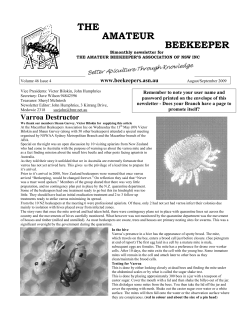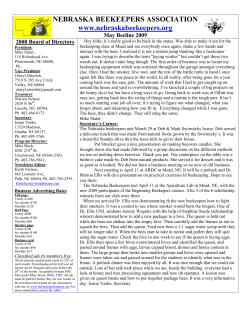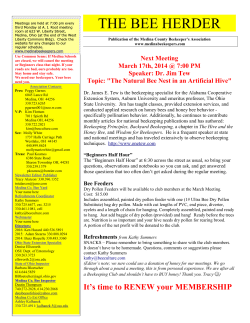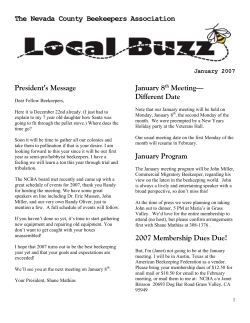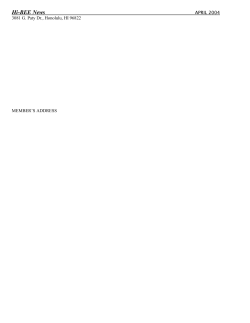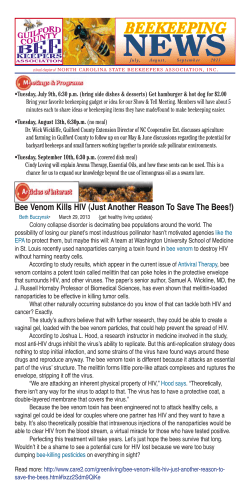
2013 Ontario Treatment Recommendations for Honey Bee Disease and Mite Control
2013 Ontario Treatment Recommendations for Honey Bee Disease and Mite Control March 2013 This document is intended as a guide for the management of pests and diseases of honey bee colonies in Ontario. It includes detailed recommendations for treatment, monitoring methods and information on the status of pests and diseases in Ontario. New items in the 2013 recommendations have been highlighted with a “new” icon. For further updates see the apiculture webpage at www.ontario/beekeeping Any recommended product is to be used only in accordance with the directions on the product’s label. The users assume responsibility for any risk to persons or property arising from the use of the recommended products. Table of Contents Treatments: Varroa Mites ........................................................................................................................................................ 3 Honey Bee Tracheal Mites ................................................................................................................................. 6 Small Hive Beetle ................................................................................................................................................ 7 American Foulbrood............................................................................................................................................ 8 European Foulbrood ........................................................................................................................................... 8 Nosema ............................................................................................................................................................... 9 Chalkbrood .......................................................................................................................................................... 9 Sacbrood ............................................................................................................................................................. 9 Monitoring Methods: Varroa Mites ....................................................................................................................................................... 10 Honey Bee Tracheal Mites ................................................................................................................................ 11 Small Hive Beetle ............................................................................................................................................... 11 American Foulbrood...........................................................................................................................................11 Small Hive Beetle Honey Bee with Varroa Mite American Foulbrood Notice Regarding Small Hive Beetle Small hive beetle, SHB, (Aethina tumida) has been confirmed in Essex, Chatham-Kent, Dufferin, Lambton and Stormont, Dundas and Glengarry Counties. The sites in Dufferin, Simcoe, Niagara, Chatham-Kent and Lambton Counties have been depopulated. There is a Quarantine Area for SHB in the entire count of Essex and the part of the Municipality of Chatham-Kent lying south-westward of a line made up of a Town Line Road, Pump Road and Merlin Road (also known as County Road 7), as if these roadways extended continuously from points of intersection with the shorelines of Lake St. Clair and Lake Erie. All beekeepers should be vigilant for the presence of this pest in Ontario. It is a requirement to report new sightings of SHB. See Apiculture webpage for more information at www.ontario/beekeeping. Visit: www.omafra.gov.on.ca/english/food/inspection/bees/quarantine_area.png; and www.omafra.gov.on.ca/english/food/inspection/bees/infosheet-shb-quar.html A permit from the provincial apiarist is required for importing bees from anywhere (another province or another country) into Ontario. See www.omafra.gov.on.ca/english/food/inspection/bees/importbees.htm for details. General Practices for all Diseases and Pests Rotate between different types of treatments whenever possible for varroa management. This will prevent the development of resistance in varroa mites. (e.g. synthetic mite-strip in spring, followed by a formic acid treatment in fall) Use particular caution when using temperature - dependent treatments above recommended temperature thresholds (e.g. formic acid, thymol). Read all labels before applying any disease or mite control products to your colonies. Treat all colonies that require treatment in the yard at the same time. Respect any withdrawal times for all treatments. Do not use treatments when honey supers are on, unless specified on the product label. Monitor colonies to determine levels of varroa infestation. Knowing the severity of the infestation will enable you to make an informed management decision on their control. The presence of multiple parasites/diseases may require treatment below the recommended treatment threshold level(s). Oxalic acid should be used only as a follow-up treatment in the late fall, after a primary early fall treatment, unless monitoring reveals very low levels of varroa. The timing of treatments and feeding is VERY IMPORTANT. Treatments need to be applied before infestations/ infections reach damaging levels. Fall feed should be provided before temperatures are too low for the bees to break cluster to access feed. Using Ontario-bred disease resistant honey bee queens in your operation may help colonies resist diseases and pests naturally. However, treatment will still be required. It is recommended to replace 2 to 3 old frames in the brood chamber (typically the darkest) every year with newly drawn comb or foundation. This practice will help to reduce the level of pathogens and miticide residues in the hive. Winter Management A colony should consist of at least 7 or 8 frames of bees at the end of the season to improve survival. It is recommended that all colonies in Ontario be wrapped for winter. Use 70% sugar syrup for fall feeding. Colonies should be very heavy before going into winter (at least 70 lbs for singles; 100 lbs for doubles). Resources For more information on bee disease, pests, biology, identification and treatment visit: Apiculture webpage www.ontario/beekeeping Honey Bee Disease Control section of the Ontario Beekeepers’ Association Tech-Transfer website http://techtransfer.ontariobee.com Technology Transfer Program Introduction to Beekeeping and Integrated Pest Management workshops www.ontariobee.com/outreach/workshops The Ontario Beekeeper Manual with an Emphasis on Integrated Pest Management is available through the Ontario Beekeepers’ Association. 2 Table 1 Varroosis: Varroa Mite (Varroa destructor) Detection: 1. Sticky board 2. Ether roll 3. Alcohol wash (see page 10 for instructions) NOTE: If varroa infestation is much higher than threshold levels (see page 11 for thresholds) in the spring and you have abnormally high losses over the winter, it is advised to check for resistance to conventional chemical product(s). Treatment Material Method of Treatment Comments Spring 65% liquid formic acid. Multiple applications: 30 to 40 ml pad for 2-story colony 15 to 20 ml for 1-story colony. Single, slow-release application: 250 ml pad in a pinprick perforated bag. Mite Away Quick Strips™ (MAQS™) NEW 46.7% formic acid Synthetic mite strips Apivar®* and Apistan® Apply one 30 to 40 ml pad for double box or 15 to 20 ml pad for single box / per hive. Place the pad on the top bars close to the brood area. The treatment is to be repeated up to six times and recommended at 3 to 5 day intervals as per label instructions. Leave treatment in for 21 to 30 days. Ensure that the populations of colonies are large enough. Colonies must have 6 or more frames of brood covered with bees when applying formic acid treatments. Outside temperature highs should be between 10 to 26°C at time of application. Temperatures above 30°C may cause excessive damage to the colonies. Complete label instructions and future updates: www.medivetpharmaceuticals.ca/Guidelines/pmra%20final% 20english%20label%20june%203.pdf The hive entrance must be open and unobstructed for all applications. Instructions for the large pad: www.ontariobee.com/sites/ ontariobee.com/files/document/250ml-pamphlet-op.pdf Treatment period is 7 days. Note: The honey bee colony cluster must cover a minimum of 6 brood frames. Consult label for instructions including placement of strips. Note: High temperatures can have a negative impact on colonies when temperature dependent treatments are used. Allow a minimum of one month between applications. To minimize residues and contamination of marketable honey, carefully follow all label instructions. Pre-Harvest Interval (PHI): Honey should not be extracted sooner than 2 weeks following the end of the treatment. The hive entrance must be open and unobstructed. Note: High temperatures can have a negative impact on colonies when temperature dependent treatments are used. Apivar® and Apistan® are registered in Ontario. Use strips according to label instructions. Extra space in the form of additional supers may buffer the effects of formic acid on honey bees. Note: When using Apivar® ensure that the appropriate number of strips is applied per frame of bees in the colony, 1 strip/5 frames of bees. Apivar® has been granted a Conditional Full Registration by Pest Management Regulatory Agency (PMRA). Check the OMAF, MRA and PMRA websites for any additional information on registration. Place strips in the brood chamber of the colony. Thymovar Use according to label instructions. Thymovar uses a novel active ingredient (thymol). Note: Two consecutive applications of Thymovar must be applied for a full treatment. Dispose of chemical strips according to label instructions. Note: Varroa populations resistant to Apistan® can be found in Ontario. Resistance will result in inadequate varroa management. However there seems to be some recovery of efficacy in Apistan. It is important to note that the recovery is variable and low recovery will result in insufficient varroa control. For techniques to identify resistance, see www.ontariobee.com/outreach/ttp Note: Always remove strips from colonies at the end of the treatment period indicated on the product label. Never reuse chemical strips. This is important to avoid the development of resistant populations of varroa mites. Note: High temperatures can have a negative impact on colonies when temperature dependent treatments are used. The temperature range for use of Thymovar is 13°C to 30°C. 3 Table 1 continued Treatment Material Method of Treatment Comments Monitor In June, check all bee yards (at least 5 hives in each) using the monitoring method of your choice to determine if varroa were controlled by your spring treatment. June Note: Refer to Table 9 on page 11 in the Notes section if further treatment options are necessary. Mite Away Quick Strips™ (MAQS™) NEW may be used during the honey flow or at anytime during the active beekeeping season. Note: High temperatures can have a negative impact on colonies when temperature dependent treatments are used. Late Spring and Summer Ontario-Selected Disease Resistant Stock Requeen colonies with new queens from Mite and Disease Resistant Honey Bee stocks. Check the OBA Tech-Transfer website at techtransfer.ontariobee.com or the OMAF and MRA website at www.omafra.gov.on.ca/english/food/inspection/bees/ apicultu.html. See updated 2013 list of Queen and Nuc producers who have tested their stock in the Ontario Mite and Disease Resistant Honey Bee Breeding Program. Drone Trapping: Using frames with drone foundation or without foundation Insert one to two frames with drone foundation or empty drone comb into the brood chamber. Remove combs containing drone cells from the brood chambers after the cells are capped and before adult drones emerge (approx. 21 days). This will remove a substantial proportion of varroa mites from your colonies. Repeat from spring until the drones are evicted from the colony in early fall and you may get results equivalent to treating with a registered product. You need a 1 in. (2.54 cm) and ½ in. (1.27 cm) spacing between the screen to the bottom board to have the varroa separated from the bees. Note: Do not leave drone combs to hatch inside colonies. This will result in the release of a large number of varroa, thereby increasing the mite infestation in the colony. Monitor In early August, check all bee yards (at least 5 hives in each) using the monitoring method of your choice to assess the severity of your varroa infestation. Screened bottom board Drone trapping instructions can be found in the factsheets and publications section of the OBA Tech-Transfer website: www.ontariobee.com/sites/ontariobee.com/files/document/Drone -Brood-Removal-for-the-Management-of-Varroa-Mites.pdf Note: Although drone trapping is labour intensive on a commercial scale, it can be used throughout the season to suppress mite infestations, even during the honey flow as no chemicals are used in this method of treatment. Screened bottom boards - incorporate 8 mesh [8 squares/inch (2.54 cm)] screens into bottom boards. Note: Although screened bottom boards may slightly enhance varroa control they will not substantially reduce mite infestations without additional treatment methods. August Note: Refer to Table 9 on page 11 in the Notes section to determine if treatment is necessary. The bees that form the winter cluster are raised in late August/early September. If they are highly infested, they will sustain enough damage that the colony will not winter properly and likely die. 4 Table 1 continued Treatment Material Method of Treatment Comments Early Fall As soon as you remove the honey supers (by mid-September) treatments should be applied. Treatments applied late in September and October have less ensured efficacy. Note: There are potential efficacy constraints caused by environmental conditions of treatments that are temperature dependent and also the potential for resistance in chemical treatments. Therefore, it is highly recommended that you monitor after the early fall treatment in order to determine if the treatment was effective or if a follow-up treatment of oxalic acid is necessary. REMINDER - It is highly recommended that the colonies consist of 7-8 frames of bees at the end of the season to improve successful over-wintering of the hives. 65% liquid formic acid. This treatment is good for both tracheal mites and varroa mites. Same as spring treatment Multiple applications: 30- 40 ml for 2-story colony; 15-20 ml for 1-story colony. Single, slow-release application: 250 ml pad in a pinprick perforated bag. Note: Refer to the most recent formic acid label for full instructions. For both ensure that the hive entrance is open and unobstructed. Ensure that colonies are large enough to have 6 or more frames of brood covered with bees when applying organic acid treatments. Outside temperature highs should be between 10 to 26°C at time of application. Temperatures above 30°C may cause excessive damage to the colonies. For complete label instructions and future updates refer to: www.medivetpharmaceuticals.ca/Guidelines/pmra%20final% 20english%20label%20june%203.pdf For instructions on the large pad visit www.ontariobee.com/sites/ ontariobee.com/files/document/250ml-pamphlet-op.pdf NEW Note: High temperatures can have a negative impact on colonies. when temperature dependent treatments are used. Mite Away Quick Strips™ (MAQS™) Apivar® or Apistan® Thymovar Treatment period is 7 days. This treatment is good for both tracheal mites and varroa mites. Note: The honey bee colony cluster must cover a minimum of 6 brood frames. Consult label for instructions including placement of strips. To minimize residues and contamination of honey, carefully follow all label instructions. Pre-Harvest Interval (PHI): Harvest honey at least 2 weeks following the end of the treatment. Ensure that the hive entrance is open and unobstructed. Note: High temperatures can have a negative impact on colonies when temperature dependent treatments are used. Use strips according to label instructions. If treating during a period when environmental temperatures are low, ensure the strips are positioned in the colony where the cluster will still maintain contact. Remove all strips after treatment. Dispose of chemical strips according to label instructions. Carefully monitor your bees and treat when monitoring results indicate that varroa levels are above the treatment thresholds. See the notes section for monitoring methods. Note: Two applications of Thymovar must be made for a complete treatment. Use according to label instructions. Late Fall Oxalic acid trickle method Apply when monitoring indicates treatment is necessary. CAUTION: Oxalic Acid may damage bee brood. Oxalic Acid will not control varroa mites in capped brood. Use only when little or no brood is present. Use only in conjunction with an early fall treatment. Do not use when honey supers are in place to prevent contamination of marketable honey. SOLUTION METHOD Note: To completely dissolve oxalic acid dihydrate, use warm syrup (not hot) and agitate thoroughly. Dissolve 35 g of oxalic acid dihydrate in 1 litre of premixed syrup made from a 1:1 sugar:water (weight:volume) mixture. Smoke bees down from the top bars. With an applicator (e.g. syringe), trickle 5 ml of this solution directly onto the bees between the frames, apply on a cool day when the bees are clustered in the hive. The maximum dose is 50 ml per colony whether bees are in nucs or single/multiple brood chambers. Under certain unfavorable conditions, (e.g., weak colonies or unfavorable over-wintering conditions), this application method may cause some bee mortality or stress to the colony. Use Oxalic Acid as a secondary follow up treatment at the time of packing the bees. Oxalic acid should only be used in conjunction with an early fall treatment to assist in killing remaining mites left on the bees. 5 FORMIC ACID PROCEDURE When using Formic Acid, make sure to seal all holes in the hive boxes except the main entrance, which must be left wide open (remove entrance reducers). To prevent danger to yourself, wear protective gear (eye protection, chemical-safe gloves, long-sleeved shirt, and closed toe shoes). Have a container of water handy to wash off any splashes. Be mindful of temperature restraints when using formic acid. Table 2 Acarine Disease: Honey Bee Tracheal Mite (HBTM) (Acarapis woodi) If infestation level is 10% or higher, treat your colonies. If you are using formic acid for varroa treatment, you do not need further treatments for HBTM. Detection: Every fall and/or spring, place 150 bees per bee yard or 50 bees per colony in alcohol and send samples to a diagnostic bee labs. See page 11 for sampling instructions and contact lab for shipping instructions. Treatment Material Method of Treatment Comments Spring It is better to wait for warmer weather, and until the bees get some brood. On really small colonies, move the brood to the side of the hive and place absorbent pad in the middle of the tops of the frames in the brood chamber. (Further details covered in label instructions). 65% liquid formic acid Use one 35 ml pad per hive. Place It is important to apply the pads 3 times, 4 days apart, for HBTM. 35-ml multiple application the pad on the top bars close to the formic acid pad (ensure brood area. For complete label instructions and future updates refer to: that a total of 3 pads are www.medivetpharmaceuticals.ca/Guidelines/pmra%20final% 20english%20label%20june%203.pdf applied) Note: High temperatures can have a negative impact on colonies when temperature dependent treatments are used. Mite Away Quick Strips™ (MAQS™) NEW Treatment period is 7 days. Consult label for instructions including placement of strips. Ensure that the hive entrance is open and unobstructed. Note: The honey bee colony cluster must cover a minimum of 6 brood frames. To minimize residues and contamination of marketable honey, carefully follow all label instructions. Pre-Harvest Interval (PHI): Honey should not be removed less than 14 days following the end of the treatment. Note: High temperatures can have a negative impact on colonies when temperature dependent treatments are used. Late Spring and Summer HBTM resistant queens Requeen your colonies with queens from HBTM resistant stocks once every 2 years. Encourage these colonies to raise more drones to help in spreading and maintaining the resistance genes. Fall After harvesting the honey crop (by mid-September) 65% liquid formic acid 35-ml multiple application formic acid pad (ensure that a total of 3 pads are applied) (same as spring treatment) Mite Away Quick Strips™ (MAQS™) (same as spring treatment) 6 Treat as described in the spring treatment after harvesting the honey crop. If you treated with formic acid in the spring, it may not be necessary to treat again in the fall. However, it is important to monitor the levels of HBTM infestation to ensure that levels in the fall samples are below 10%. Table 3 Small Hive Beetle (SHB) (Aethina tumida) Detection: The larval and adult stages of SHB and damage caused by the larvae of SHB can be observed in the honey bee colony or on exposed hive equipment. SHB is restricted in distribution. All beekeepers must be vigilant for its presence. All beekeepers must report the presence of SHB to the Apiculture Program (OMAF and MRA). See: www.omafra.gov.on.ca/english/food/inspection/bees/info-shb.htm Treatment Material Method of Treatment Comments Throughout Beekeeping Season Best management practices. More than any chemical treatment, the most important factor to minimize SHB damage is to maintain strong, healthy, populous colonies. Take immediate action to address weak or failing colonies. Promptly requeen failing queens. Do not leave dead honey bees and used equipment exposed. Very Important: Beekeepers should follow all biosecurity practices when managing SHB. Beekeepers can not move infested or potentially infested honey bee colonies and equipment to new beeyards. Ensure that colonies do not have large areas of the hive that are not protected by worker bees. Monitor colonies for the presence of SHB, mechanical traps can be used throughout the season. For more information on SHB biosecurity visit www.omafra.gov.on.ca/ english/food/inspection/bees/ biosecurity.htm Spring and Fall Honey Bee Colonies - Outside of the nectar flow Chemical free oil trap NEW Follow instructions of the specific type of trap. Monitor on a regular basis (every second week). Chemical free traps may be used at any time of year. Note: This option will not control SHB populations. These traps may kill a few adults. The main advantage is as a monitoring tool. The best prevention for SHB infestation are biosecurity practices and the best prevention of damage is management practices. Ensure that no brood is brought into the honey house with honey supers, particularly when managing colonies without queen excluders. Use biosecurity practices whenever you are working in an beeyard that may have SHB. Avoid actively spreading SHB from one location to another. It is particularly important that the honey house does not become infested as SHB may move to any yard from a central location. Sterilizing honey supers by freezing before they arrive at the honey house is one option. At a larger Consult with the Provincial Apiarist for further details. If a location is quarantined for SHB the only way material may be moved is through inspection and permits, and only under certain circumstances. Extraction Facility Best management practices. Extract honey supers promptly, ideally within 2 days, no more than four. Clean extracting facilities on a regular basis. Store wax cappings in sealed containers. Maintain the humidity of hot rooms at less than 50% relative humidity. 7 Table 4 American Foulbrood (AFB) (Paenibacillus larvae) Control measure: This is a serious, readily transmissible disease. Be aware of the symptoms for this disease. Action should be taken immediately after AFB is found to prevent further spread of the disease (see below). There is no cure for AFB. However, several preventative actions can be taken. Treatment Material Method of Treatment Comments Spring and Fall OXYTET-25-S or OXYSOL-62.5 powdered sugar mix. Follow the label directions for preparation of material. Label must indicate that the mixture can be used for honey bees. Treat according to the label on OXYTET25-S or OXYSOL-62.5 with the powdered sugar mix along the margins of the brood chamber. Be careful not to put powdered mix directly on to open brood. Repeat 3 times at 4-5 day intervals in the spring and in the fall. Stop treating 4 weeks before the main honey flow. Preventative Measure: All bee colonies should be treated. Other methods of application are not to be used, such as sugar syrup method or products such as pollen substitutes as carriers, as this can contaminate honey, is less effective and will promote resistant AFB strains. Note: Oxytetracycline is the only antibiotic that is registered for use on AFB in honey bees. Throughout Beekeeping Season At any time when colonies show symptoms of AFB (e.g. brown scales and sticky to ropy dead larvae) Burn all infected equipment and kill the bees Burn all frames, bottom boards and bees of infected hives. Scorch empty bee boxes, inner covers and lids. See OMAF and MRA recommendations or consult with your local Bee Inspector for further instructions. For instructions on destruction and sterilization visit www.omafra.gov.on.ca/english/food/ inspection/bees/destructionprotocol.htm Report to your Bee Inspector immediately and ask for recommendations. AFB is reportable under the Bees Act. Treat the rest of the bee yard with OXYTET-25-S or OXYSOL-62.5 powdered sugar mix Treat all remaining colonies with OXYTET-25-S or OXYSOL-62.5 powdered sugar mix. Repeat 3 times at 4 to 5 day intervals. Stop treating 4 weeks before the main honey flow. Disinfect contaminated empty hive parts using irradiation. Supers with frames without bees should be placed in containers that are inaccessible to honey bees (“bee tight”) for irradiation. Perform regular inspections on all remaining colonies for any symptom of AFB. Gamma irradiation Contact: www.omafra.gov.on.ca/english/food/inspection/ bees/info_beeinspectors.htm at 1-877-424-1300 or by email at [email protected] Using 1.2 m rads will completely sterilize the combs and hive parts. Contact the office of the Provincial Apiarist. Table 5 European Foulbrood (EFB) (Mellisoccus pluton) Control measure: You do not need to kill the bees as with AFB. Replace infected combs with new non-infected combs or foundations. Treatment Material Method of Treatment Comments Spring and Fall OXYTET-25-S or Treat according to the label on OXYTETPreventative measure: Same as AFB. OXYSOL-62.5 powdered 25-S or OXYSOL-62.5 as described for sugar mix AFB. At any time when colonies show symptoms of EFB (e.g. brown, twisted larvae). Replace infected combs Burn or irradiate all removed infected combs as above. OXYTET-25-S or Treat according to the label on OXYTETTreat all colonies with OXYTET-25-S or OXYSOL-62.5 OXYSOL-62.5 powdered 25-S or OXYSOL-62.5 as described for powdered sugar mix. Repeat three times at 4-5 day sugar mix AFB. intervals. Stop treating 4 weeks before the main honey flow. New queens Pollen supplements 8 Requeen colonies in the bee yard with new queens from Mite and Disease Resistant Hygienic stocks. Honey bee colonies may be more prone to EFB during and immediately after intensive berry pollination. This may be related to nutrition. Table 6 Nosema (Nosema apis; Nosema ceranae) Detection: Obtain at least 50 adult bees from the front entrance of suspected colonies and send to a bee testing laboratory for diagnosis. Note: The new species of nosema, Nosema ceranae, may be a problem throughout the season. Beekeepers can monitor spore levels regularly. Treatment Material Method of Treatment Comments Feed bees a mix of Fumagilin-B with sugar syrup in spring if you have a high level of infection (> 1 million spores/bee). Protect your Fumagilin-B medicated sugar syrup from direct sunlight when feeding bees. This threshold may not reflect the current virulence of nosema. The University of Guelph (Townsend House) and the Tech Transfer Program are addressing the virulence of nosema through applied research. Replace 2 to 3 old brood combs (typically darker) from the brood box to reduce the level of nosema and accumulation of acaricides in the wax. Spring Fumagilin-B Spring feeding with Fumagilin-B is important. Current research on the seasonal patterns of nosema in Ontario demonstrates that the levels of nosema increase in June. To ensure individual colonies receive the accurate dose of Fumagilin-B, mix as per label instructions and apply using direct-to -colony feeding techniques (bag feeding, pail feeding, etc.). Barrel feeding Fumagilin is not effective as the dosage is not standardized and the drug settles to the bottom of the barrel. Late Spring/Summer New queens Requeen colonies when new queens are available. Feed bees a mix of Fumagilin-B with sugar syrup as described above. The fall feeding may protect bees during the winter season. Fall Fumagilin-B Table 7 Chalkbrood (Ascosphaera apis) Treatment Material Method of Treatment Comments Requeen There is no registered chemical treatment for Chalkbrood. Maintain strong, healthy colonies and requeen with queens from hygienic stocks. Spring and Summer New queens Table 8 Sacbrood (Virus) Treatment Material Method of Treatment Comments Requeen There is no registered chemical treatment for Sacbrood. Maintain strong, healthy colonies and requeen with queens from hygienic stocks. Spring and Summer New queens Toxicological Information 65% Formic Acid: www.hc-sc.gc.ca/cps-spc/pubs/pest/_pol-guide/dir2010-03/index-eng.php Oxalic Acid: www.hc-sc.gc.ca/cps-spc/pubs/pest/_decisions/rd2010-12/index-eng.php Thymol: www.hc-sc.gc.ca/cps-spc/pest/part/consultations/_prd2010-18/prd2010-18-eng.php CheckMite+™: www.hc-sc.gc.ca/cps-spc/pest/part/consultations/_pmrl2008-31/coumaphos-eng.php Permanone®: www.hc-sc.gc.ca/cps-spc/pest/part/protect-proteger/food-nourriture/mrl-definitions-lmr/ index-eng.php 9 Notes: No chemicals should be used in bee colonies when honey supers are on the colony or when any honey is produced for human consumption, unless otherwise specified by the label instructions. Read the labels of products carefully before use in the beehives and follow instructions and recommendations. Be sure to respect withdrawal times for all treatments. Take all the appropriate safety measures (equipment, clothing) as recommended by the label directions when mixing/applying treatments. For diagnostic samples, discuss sampling and shipping methods with the diagnostic bee labs. See: www.ontariobee.com/outreach/ttp MONITORING METHODS Varroa Mite Sticky Board Coat a thick piece of paper (38 cm x 30 cm) (14.96 in x 11.81 in) filing folders work well, using 50 % Vaseline, 50 % Crisco, Tangle Trap paste or sticky material. Place the coated paper under a screen, on the bottom board for three days. Count the varroa mites on the sticky board and divide by 3 to obtain an average mite fall per day. The sticky boards can also be left in colonies until you return to the yard on the next trip. This will assure that the mites that drop onto the sticky board cannot return to the bees. Ether Roll Place ½ cup of bees (approximately 300 bees) from the brood chamber in a glass jar. Spray with 3 to 4 squirts of ether (engine starter fluid). Replace lid and shake for 1 minute. Roll the jar, then count the varroa stuck to the glass and under lid. Do this in a well ventilated area and wear gloves to minimize contact with the ether. Alcohol Wash Place ½ cup of bees (approximately 300 bees), from the brood chamber, into a container with alcohol so that the bees are completely immersed, (windshield washer fluid), shake vigorously. Pour bees onto a screen, over a white tub and vigorously rinse varroa from bees with the remaining alcohol. Count the total number of varroa in tub. Handheld, easy to use, commercially made mite shaker devices that give effective and fast results are available. Follow the directions provided with the shaking apparatus. Contact your local bee supply outlet for availability. For more information see: Technology Transfer Program www.ontario.com/outreach/ttp OMAF and MRA Apiary Program www.ontario/beekeeping Varroa Mite Threshold Levels The following are treatment guidelines. These suggested levels will vary depending on colony strength, apiary location and management. The best way to determine the proper timing for treatment solutions is to monitor regularly and compare results. In most cases, beekeepers must treat in both spring and fall to effectively manage varroa. Table 9. Threshold guidelines for varroa mite levels in May and August. NOTE: TREATMENT LEVELS HAVE BEEN LOWERED FROM PREVIOUS RECOMMENDATIONS. Treat when varroa levels are equal or greater than the following: 10 Monitoring Method Number of Varroa Mites in May Number of Varroa Mites in August Ether Roll 1 mite/100 bees 2 mites/100 bees Alcohol Wash 2 mites/100 bees 3 mites/100 bees Sticky Board 9 mites/24 hr drop 12 mites/24 hr drop Honey Bee Tracheal Mites Tracheal Mite Threshold Level: Treat when infestation levels are at 10%. Alcohol Sample: Place approximately 150 bees per bee yard or 50 bees per colony into a container with alcohol and contact a diagnostic lab. Visit www.ontariobee.com/outreach/ttp Small Hive Beetle (SHB) It is a requirement under the Ontario Bees Act to report SHB. All beekeepers in Ontario should be on the look out for SHB in their operation as a precaution. Examine the tops of brood frames (particularly towards the ends of the frames) for the presence of SHB adults immediately after the lid is removed. Adult and larval beetles may also be encountered on the surface of brood frames amongst worker bees. A variety of mechanical traps may be used to monitor for SHB. Consult bee supply outlets for a range of options. Adult and larval SHB can also be found in dead colonies and exposed colony equipment. For further details of identification and biology of SHB, see: www.omafra.gov.on.ca/english/food/inspection/ bees/info-shb.htm and www.omafra.gov.on.ca/english/food/inspection/bees/shb-reportfdinings.pdf If you suspect that you have SHB in your operation, CONTACT YOUR REGIONAL BEE INSPECTOR by email at [email protected] or 1-877-424-1300 or [email protected] American Foulbrood (AFB) It is a requirement under the Ontario Bees Act to report AFB. Examine brood frames as you open colonies. Symptoms of AFB include a scattered brood pattern and cappings with a punctured, sunken, dark and greasy appearance. Infected larvae settle to the bottom of the cell wall in a sunken gooey mass, beige to dark brown in colour. Insert a toothpick into the cell and draw out the contents. AFB will draw out ½ in. and has the consistency of mucous. Check empty cells on brood frames for AFB scales (hardened dark black masses of old dead larvae). Contact your Regional Bee Inspector at www.omafra.gov.on.ca/english/food/inspection/bees/ info_beeinspectors.htm if you are unsure of your diagnosis of AFB or if you find AFB. Further information about AFB can be found on the Apiculture Program webpage or the OBA Tech-Transfer Website at http://techtransfer.ontariobee.com. DIAGNOSTIC BEE LABS: See the Technology Transfer Program website: http://techtransfer.ontariobee.com www.ontariobee.com/outreach/ttp RECORD KEEPING: Record keeping is essential to monitoring for pests and disease. Example - Date: Yard Colony # Tracheal Mite % Varroa Level Avg Nosema Spores/Bee Strength: 1 - 3 Note: The type and dates of treatments should also be documented in your record keeping. 11 New Infosheets Introduction to honey bee pests and diseases www.omafra.gov.on.ca/english/food/inspection/bees/ intro-bees-pests.pdf Overview of Beekeeping Regulations in Ontario: What you should know if you own honey bees www.omafra.gov.on.ca/english/food/inspection/bees/ beekeepingregulations.pdf Varroa mite – biology and diagnosis www.omafra.gov.on.ca/english/food/inspection/bees/ varroa-biology.pdf Varroa mite – sampling and monitoring www.omafra.gov.on.ca/english/food/inspection/bees/ varroa-sampling.pdf American foulbrood – biology and diagnosis www.omafra.gov.on.ca/english/food/inspection/ bees/afb-biology.pdf American foulbrood – prevention and management www.omafra.gov.on.ca/english/food/inspection/ bees/afb-mgmt.pdf Small hive beetle report www.omafra.gov.on.ca/english/food/inspection/ bees/info-shb.htm Honey bee pests and diseases images www.omafra.gov.on.ca/english/food/inspection/ bees/honeybeepestphotos.htm Tech Transfer factsheets www.ontariobee.com/outreach/fact-sheets-andpublications Author credit This Infosheet was authored by Paul Kozak - Provincial Apiarist/OMAF and MRA; Les Eccles, Melanie Kempers, Devan Rawn, Brian Lacey - Technology Transfer/OBA and Dr. Ernesto Guzman – University of Guelph. Contact information Paul Kozak, Provincial Apiarist Ontario Ministry of Agriculture and Food Ministry of Rural Affairs 1 Stone Road West, 5th Floor NW Guelph, Ontario N1G 4Y2 Tel: 519-826-3595 Fax: 519-826-4375 E-mail: [email protected] Ontario Beekeepers' Association, Technology-Transfer Program Orchard Park Office Centre, West Door C Suite B47, 5420 Highway 6 North Guelph, ON N1H 6J2 Tel: 519-836-3609 E-mail: [email protected] For more information: Telephone: 1-877-424-1300 E-mail: [email protected] www.ontario.ca/omafra 12
© Copyright 2025


